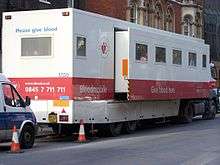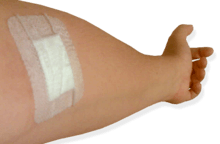Blood donation in England

In England, blood and other tissues are collected by NHS Blood and Transplant (NHSBT), which also processes and supplies blood products to hospitals in the country through the Bio Products Laboratory. NHSBT was previously known as the National Blood Service until it merged with UK Transplant in 2005 to form a NHS special health authority. Other official blood services in the United Kingdom include the Northern Ireland Blood Transfusion Service, the Scottish National Blood Transfusion Service and the Welsh Blood Service.
Donations
The service depends entirely on voluntary donations from the public. Originally, Blood was collected from various donor clinics located over the country. In 1994, the first mobile session was held in Elstree, hosted by the Joely Bear Appeal. Currently, Blood donation sessions are set up throughout the country and take place in many diverse venues. From village halls, to mobile collection units (known as Bloodmobiles), and sessions set up companies and organisations so people can donate at work. Donors are generally required to be fit and healthy, weigh 50 kilograms (110 lb; 7 st 12 lb) and be aged between 17 and 60. However, regular (healthy) donors are permitted to donate past the age of 60 as long as they remain healthy. Donors are encouraged to give blood up to three times a year (once every 16 weeks).
Pre-donation and exceptions
Prior to each donation, the donor's iron level is checked to make sure they are not anaemic. The donor will be required to fill in a questionnaire to provide consent and declare that the donation will be safe (for example, stating that the donor does not have a heart condition), and it is safe to give the donor's blood to someone else.
- Weight
- To give blood donors must weigh over 50 kilograms (110 lb; 7 st 12 lb). For donors who are female, aged under 20 years old, weigh under 60 kilograms (132 lb; 9 st 6 lb) and are under 168 cm (5 ft 6 in) height, the blood service will need to confirm their estimated blood volume is over 3500 ml.[1]
- HIV
- Every single blood donation is tested for HIV (the virus that causes AIDS) and Hepatitis B and C. Infected blood is not used in transfusions but tests may not always detect the early stages of viral infection.[2]
- Pregnancy/Travel
- Women should not give blood if they are pregnant or have had a baby in the last six months. People should wait six months after returning from a malarial area before giving blood, and should inform the National Blood Service if they have visited Central or South America at any time.[2]
- People who cannot give blood
- People should not give blood if they have donated with less than 12 weeks' interval between donations, or 16 weeks if they are female. If they have a chesty cough, sore throat or active cold sore, are currently taking antibiotics or you have just finished a course within the last seven days or have had any infection in that last two weeks.[2]
- If they have had hepatitis or jaundice in the last 12 months, or had a tattoo, semi-permanent make up or any cosmetic treatments that involves skin piercing in the last 4 months.[2]
- If they have had acupuncture in the last 4 months, unless this was done within the NHS or by a qualified healthcare professional registered with a statutory body.[2]
- If a member of their family (parent, brother, sister or child) has suffered with CJD (Creutzfeldt–Jakob disease) or if they have ever received human pituitary extract (which was used in some growth hormone or fertility treatments before 1985).[2]
- If they have received blood or think they may have received blood during the course of any medical treatment or procedure anywhere in the world on 1 January 1980.[2]
- People who may not be able to give blood
- People who have had a serious illness or major surgery in the past or are currently on medication, or if they have had complicated dental work. People who have had simple fillings are ok to give blood after 24 hours, as are simple extractions after 7 days.
- People who have been in contact with an infectious disease or have been given certain immunisations in the last four weeks, as well as people presently on a hospital waiting list or undergoing medical tests.[2]
- People who can never give blood
- People who have ever had syphilis, HTLV (Human T-lymphotropic virus), HIV or Hepatitis C, worked as a prostitute, or have ever injected themselves with drugs.[2]
- People should not give blood for 12 months after sex with
- A man (if they are male).
- Men who have had anal or oral sex with another man (with or without a condom) are deferred from blood donation for 12 months.
- A man who has had sex with another man (if you're a female).
- A prostitute.
- Anyone who has ever injected themselves with drugs.
- Anyone with haemophilia or a related blood clotting disorder who has received clotting factor concentrates.
- Anyone of any race who has been sexually active in parts of the world where AIDS/HIV is very common.[2]
Donating blood
Once the preliminary checks are complete, the donor lies on a bed and a sterile hypodermic needle connected to a bag is inserted into a vein in their inner elbow. The donation usually lasts between five and 10 minutes, during which 470 millilitres (17 imp fl oz) of whole blood is given.
Post-donation

Following the donation (and subsequent dressing of the wound), donors are invited to refreshments. This period serves two vital purposes: to replace certain lost fluids, and to allow staff to monitor the donor's wellbeing.
Donations can also be taken by machines called cell separators, usually in larger blood donation centres located in city centres. These machines use a process called apheresis to collect either blood plasma only, or plasma and platelets, the other blood cells being returned to the patient. Platelets are the tiny fragments of cells in the blood which help it to clot and so stop bleeding, and are used in the treatment of cancer and leukaemia. A constant supply is vital because platelets only last five days once collected. People who give plasma and/or platelets can donate every two weeks, and each donation usually gives two or three adult doses. One adult dose of platelets would otherwise require four whole blood donations.
Blood Component donations
Blood is made in the bone marrow. It is composed of red blood cells, platelets, plasma and white blood cells, collectively referred to as blood components. Donations given at regular blood donation sessions are referred to as "Whole Blood". Platelets are very small cells. They work with the clotting factors in plasma to form a mesh "plug" to stop or prevent bleeding. Plasma is the fluid part of the blood. It contains protein, salts and clotting factors. White cells fight harmful bacteria and help prevent infection. Red cells carry oxygen from the lungs to the tissues.
Most platelet donations are given to patients who are unable to make enough platelets in their bone marrow. For example, patients with leukaemia or other cancers may have too few platelets as the result of their disease or treatment. Also after major surgery or extensive injury, patients may need platelet transfusions to replace those lost through bleeding. Platelets are often life-saving and special in that they can help up to 3 adults or even 12 children. As platelets can only be stored for a few days, regular and frequent donors are in great demand and that is why platelet donors are asked to attend at least 8 - 10 times per year.
Controversy
The service had come under criticism for a long implemented policy of banning men who have sex with men (MSM) from ever being blood donors. University students in both England and Scotland protested against the ban,[3][4] and University of Birmingham's Guild of Students banned the National Blood Service from setting up a recruitment stall during Freshers' week.
The policy was changed and the ban on MSMs was amended so that MSMs are now not allowed to donate for 12 months after having anal or oral sex with another man (with or without a condom). Additionally women cannot donate for 12 months if they have had sex with a man who has had sex with another man.[2]
Legal
A vs The National Blood Authority (Queens Bench Division).[5] This trial concerned the claims of 114 Claimants, for recovery of damages arising out of their infection with Hepatitis C, from blood and blood products through blood transfusions from 1 March 1988. All the claimants received blood transfusions or blood products usually in the course of undergoing surgery, whether consequent upon having suffered an accident or otherwise, immediately after childbirth.
See also
References
- ↑ "Give Blood - FAQs". NHS Blood and Transplant. Retrieved 6 February 2015.
- 1 2 3 4 5 6 7 8 9 10 11 "Who Can't Give Blood". NHS Blood and Transplant. Retrieved 30 December 2014.
- ↑ "Students protest gay donor ban". Pink News. 6 February 2006. Retrieved 2007-10-22.
- ↑ "Students want gay blood rethink". BBC News Online. 23 February 2006. Retrieved 2007-10-22.
- ↑ "Archived copy". Archived from the original on 2009-09-01. Retrieved 2010-08-01.
External links
| Wikimedia Commons has media related to National Blood Service. |
- National Blood Service
- Save Our Blood Service - campaign against centralisation
- Amicus (Unite) NBS section - discussion documents and press releases from one of the unions representing NBS technicians, regarding service restructuring and governance